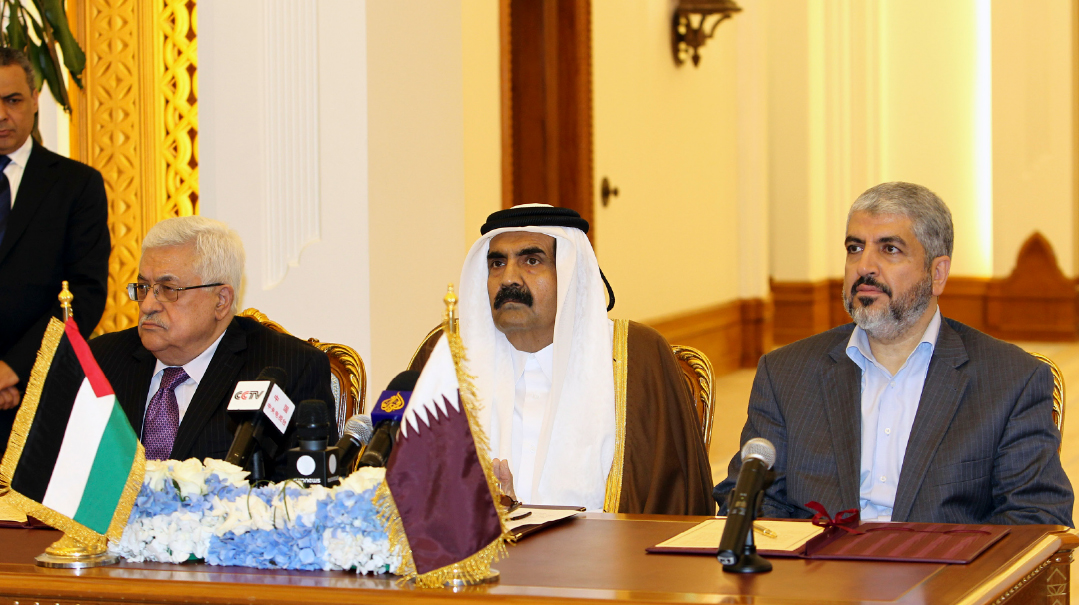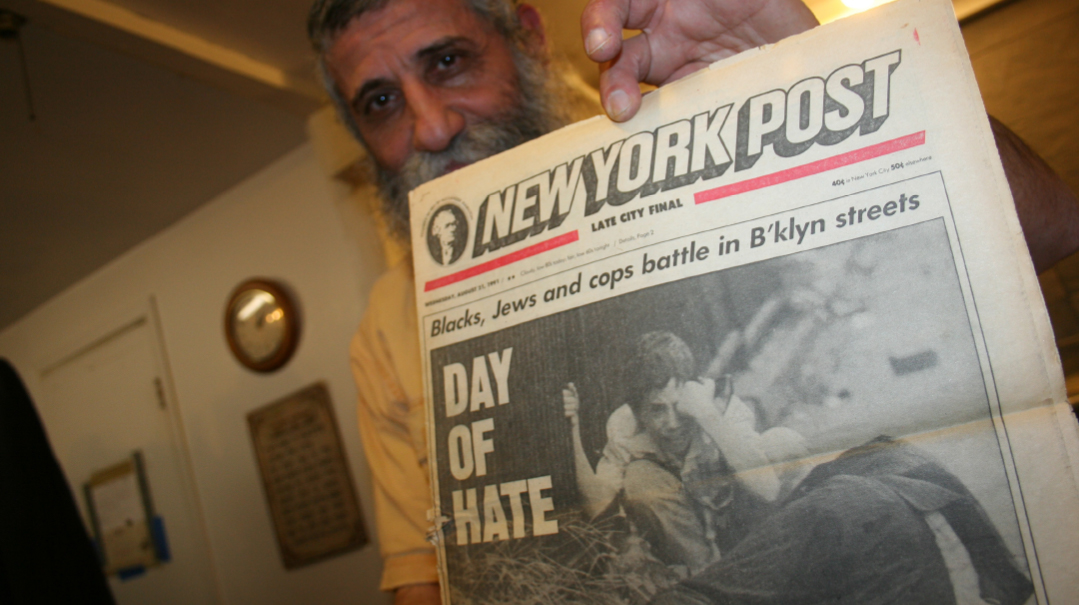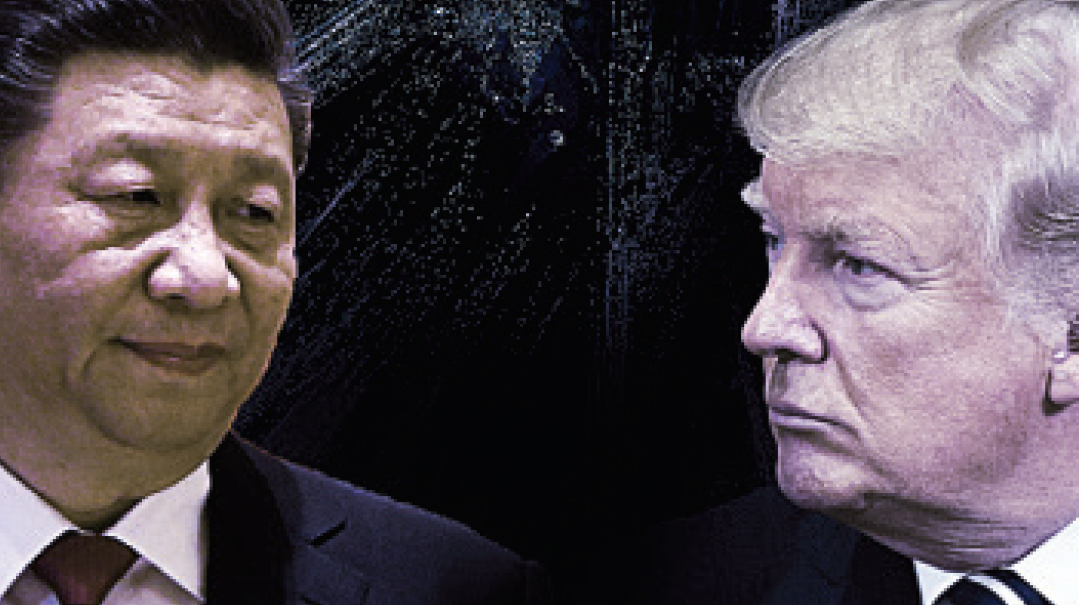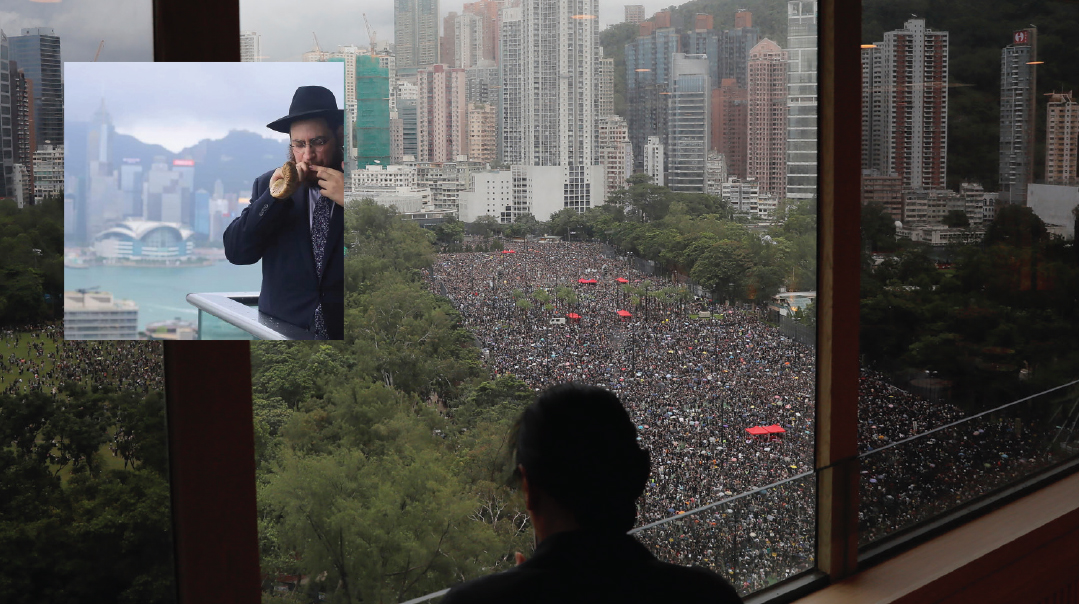Bittersweet Return




As selected hostages emerge from Gaza, joy mingles with dread

A pale little boy running into his father’s arms.
An elderly woman swept up in her daughter’s embrace.
Women and girls emerging from captivity.
Even in the emotion-soaked weeks since October 7, these images stand out.
Because even as the captives emerge, there is the dread realization that some — especially soldiers and military-age men — might never return. For Hamas, the cease-fire and hostage release has been about gaining time to regroup, and about ridding themselves of the image problem that snatching defenseless women and children has brought. When that job is over, will Hamas be so easily be persuaded by its Qatari sponsors to continue the hostage release? No one knows.
Added to that is the sense that, despite the pounding it’s taken in northern Gaza, the terror group is far from done. Even as it releases captives, Hamas is still calling the shots: by reneging on the terms of the hostage deal — separating a mother from her child, taking its time in freeing American citizens in a not-so-subtle message to President Biden — the group is intent on proving to its people and the world at large that it remains a force to contend with.
Bitter experience dating back to the disastrous Shalit deal in 2011 has taught Israelis that a released terrorist is a danger once again to innocent civilians. Technically, none of the many Palestinians who’ve left Israeli jails over the past few days have blood on their hands — but only because their attempts to kill didn’t work.
Last, there’s the bitter taste of humiliation. In Israelis’ dreams, the return of the hostages was meant to look different — a daring special forces raid to spring them from the terrorists’ lair. Instead, Israelis are forced to watch as Gazans spit and curse the Red Cross jeeps taking the defenseless passengers to freedom. Instead of Entebbe, it’s the abject failure of the Yom Kippur War’s opening — without the subsequent military triumph.
Nearly two months into the war, American patience is wearing thin, splits are emerging in Israel’s war cabinet and the IDF war machine is deprived of the initiative. Israel’s leaders remain adamant that southern Gaza is in their crosshairs, and that toppling Hamas is nonnegotiable. The terror group, in turn sees a path to victory.
In the great play for Gaza, Act I is over, and the question is what comes next.
What If The War Ended Today?
Binyamin Rose

Photo: Flash90
For more than 50 days and 50 nights, the IDF has battled Iranian proxies on multiple fronts; hounding Hamas terrorists from the streets and tunnels of Gaza; targeting Hezbollah militiamen and fortifications in Lebanon and Syria; and shooting down missiles launched toward Eilat by Houthi rebels based in Yemen. All this while the expanded Israeli unity government masterminds a global diplomatic campaign to buy enough time to eliminate the Hamas threat forever. At press time, a cease-fire-for-hostages exchange was still in effect, with no certainty as to whether, when, or how the war would continue.
If the war ended “today,” could Israel claim victory? Are Jews in Israel safer and more secure than we were seven weeks ago? How long will US support hold up, and how firm are the Abraham Accords? And how will the fallout from the war impact Israel’s political future and the impressive outpouring of Jewish unity?
The Long Road Toward Victory
Four weeks into the ground invasion of Gaza, the IDF is still far from its stated goal of erasing Hamas from the military and political map. The IDF has killed an estimated 5,000 Hamas soldiers, which is anywhere from 20% to 33% of its fighting force, and caused heavy casualties to at least 10 of Hamas’s 24 battalions. The IDF has gutted much of Hamas’s infrastructure in northern Gaza, but large swaths of central, and all of southern Gaza remain under Hamas control.
The cease-fire required Israel to sharply curtail its reconnaissance over southern Gaza, enabling Hamas to regroup and perhaps move some of the remaining hostages around. The IDF captured Hamas’s command center underneath Shifa Hospital without harming patients, but it was far from a Palestinian Waterloo. Hamas terrorists fled well in advance, leaving few traces of their infrastructure behind, turning the IDF conquest into something symbolic and anticlimactic.
Whether or not fighting resumes after the cease-fire, and on what scale, expect IDF troops to remain in Gaza for the long haul to continue rooting out terror infrastructure and to reduce the risk of further infiltrations into Israel. As time goes on, Israel will face increasing international pressure to allow Arab residents to return to their homes in north Gaza and start rebuilding. The Israeli government has announced plans to rebuild the Jewish communities alongside Gaza that were destroyed in the Simchas Torah attack, but Jewish residents are unlikely to move back unless they feel their security is guaranteed. We’re still far away from that happening.
The Limits of Brains and Brawn
The war has exposed the IDF’s strengths and weaknesses, both in its abilities as a fighting force and in the realm of intelligence gathering. The IDF has built a reputation as one of the world’s most powerful armies thanks to a longstanding American commitment to provide Israel with the arms it needs to maintain a qualitative military advantage over its enemies. However, Hamas has perfected the art of fighting what’s called an asymmetric war, inflicting damage on better-armed Israeli forces by utilizing “hit and run” tactics while using Gaza’s civilian population as human shields to deter the IDF from an all-out attack.
The IDF has adjusted well, and according to foreign press reports, Israel has purchased and deployed advanced drones equipped with artificial intelligence systems to track and destroy terrorists hiding in tunnels and other inner-city spaces. Regarding intelligence failures, the “party line” has been to wait until after the war to assign blame. But over the weekend, published reports indicated that a month before Simchas Torah, soldiers monitoring the front lines had passed along specific warnings to their superiors that Hamas was training for precisely the type of mission they executed, but the warnings were dismissed at the highest levels of IDF intelligence.
To date, many top IDF officials have already confessed to errors of omission, including underestimating Hamas’s capabilities and how their hatred of Israel motivates them to commit unspeakable acts of violence and terror. There will be a thorough housecleaning after the war, just like there was in 1974, following eerily similar intelligence failures that led up to the Yom Kippur War.
The Limits of American Support
Relations between the Biden administration and the Netanyahu government, which were on a sharp downhill slope most of the year, improved dramatically following the Simchas Torah invasion. Shaking off the perception that he is old and ineffective, President Biden responded with vigor, showing solidarity in a quickly planned visit to Israel, dispatching warships to the Mediterranean, and warning Iran and Hezbollah to stay out of the fray.
American aid comes with strings attached, and the Biden administration has tampered with and tempered Israel’s war plans, but it was one giant step in making amends for the way the administration publicly sided with opponents of the Netanyahu government’s plans for judicial reform. The criticism, which included US declarations that Israel was at risk of abandoning the shared democratic values that bonded the two nations, degraded Israel in the eyes of its enemies and likely emboldened its enemies to strike. Even today, the two strategic allies disagree on the level of humanitarian aid Israel is expected to facilitate, and most importantly, they strongly disagree on who should rule in Gaza if Israel topples Hamas.
The war, and its aftermath, have already become a 2024 presidential campaign issue; progressive Democrats have ramped up their pressure on Biden to back down from his steadfast support for Israel. It will impact Israeli politics very soon.
While Israelis of all stripes have pulled together in an impressive display of unity, to support the war effort and offer tzedakah and chesed to war victims, it would be premature to equate unity of purpose with a meeting of the minds or to think that the traumatic attack transformed Israelis into Ben Gvir voters. Just the opposite. The latest polls show that voters will punish the Likud in the next election and a center-left coalition led by Benny Gantz would likely take power.
The Muslim World Watches and Waits
We don’t know how close Israel and Saudi Arabia might have been to normalizing relations before October 7, but we do know that any deal is on ice until the dust kicked up from Gaza’s sandy beaches settles. In that sense, Iran has won at least a minor victory in its goal to throw a spoke into the wheels of a US-sponsored Saudi-Israeli rapprochement. Any delay slows American efforts to reverse its declining influence in the region, and that plays into Iranian — and Chinese and Russian hands.
Having said that, aside from offering some lip service to the Palestinian cause, the other Abraham Accords nations have maintained their relations with Israel. Over the weekend, a group of top foreign ministry officials from Qatar set foot on Israeli soil, flying directly to Israel on a private corporate jet to mediate a breakdown in the hostage release deal, and Egypt is also cooperating closely with Israel and the US.
Israel’s military campaign hasn’t harmed its relations with Arab nations. If Hamas disappeared tomorrow, none of them would shed more than a crocodile tear. The Abraham Accord nations, and those considering joining, view Israel as a bulwark in its opposition to the Iranian axis that threatens them too. They know that the better they get along with Israel, the more likely they are to receive US military and economic aid.
These Arab nations are keeping a close eye on the US and Israel to see if they continue to show resolve and stand firm in their goal of eradicating Hamas and weakening a linchpin of the Iranian axis, or if they lose their nerve and patience and buckle under a variety of electoral or international political pressures.
Patience Is Wearing Thin
Avi Blum Esq.

Photo: Flash90
1
From a tunnel deep under the Gaza Strip, Hamas leader Yahya Sinwar continues playing the Israeli government. Having mastered Hebrew during his two decades of incarceration, Sinwar, an avid consumer of Israeli media, continues tormenting an entire country.
The hectic days since the war cabinet adopted the hostage deal have taught the nation that despite the beating Hamas has taken, its operating system hasn’t changed one bit. Hamas continued brazenly violating agreements as if it hadn’t just received a death blow over weeks of intense fighting.
First, Hamas played with the timing and delayed the cease-fire by an entire day. Then, the release of the second batch of hostages was delayed by seven hours because Hamas, in complete violation of the stipulation not to separate families, released a 12-year-old girl without her mother.
All this happened after Netanyahu, Gallant, and Gantz convened an early press conference over the weekend. When Netanyahu spoke of targeting Hamas leaders even as he negotiated with them, his government once again came across to Israelis and Palestinians alike as making threats it couldn’t back up.
Presumably, Yahya Sinwar obsessively followed Israeli media coverage of the tense hours during the delay of the second group’s release. In fact, that was Sinwar’s goal: proving that despite the blow it’s received, Hamas continues dictating the conditions and pace of events. Several unfortunate family members of captives — who obviously can’t be blamed — made comments to this effect during the long wait, and Israeli government ministers were beside themselves with embarrassment.
In an attempt to relieve the dejected atmosphere, Chief of Staff Herzi Halevi and Defense Minister Yoav Gallant released an earlier-than-expected statement about continuing the ground offensive in full force as soon as the hostages were released. But the Israeli public is sick of such statements, and no bluster could dissipate the sense of malaise.
2
Hamas’s cunning, cynical execution of the deal reopened the war cabinet’s internal disagreements raised during their deliberations of it. From the first days of the war, two camps emerged within the war cabinet. On one side were Netanyahu and Gallant, who saw the toppling of Hamas as the primary aim of the war and the release of the hostages as a secondary objective.
On the other side were the two late entrants to the government, Gantz and Eisenkot of National Unity, who from day one talked about the release of the hostages as being as important as the toppling of Hamas, if not more so.
Hamas’s primary motive for accepting the deal at this juncture was obvious. After almost 50 days of combat, Hamas had effectively lost control of the northern Gaza Strip, which has been pulverized. Had the ground offensive continued, the IDF would currently be engaged in operations to conquer the south of the Strip. Hamas desperately needed the truce.
But Hamas also realized that the children and elderly hostages are less an asset than a liability to the terror group’s goals. Israel’s continued international credit, especially from the US, stems largely from the absolute illegitimacy of Hamas holding babies, women, and the elderly as hostages.
Had the deal been offered two weeks ago, Hamas would never have accepted the current terms. The dilemma facing Israel’s decision makers was whether to continue pressure on Hamas to create conditions for an even better deal or just bring home as many hostages as possible, immediately. Netanyahu wavered between Gantz and Eisenkot, who supported a deal, and Gallant, who leaned against it before ruling in favor.
“We can’t accept the risk that if we wait any longer, some of the hostages may no longer be alive,” Netanyahu said.
The condition that enabled the war cabinet to coalesce around the deal was the limit on the length of the truce in advance and making it clear that the fighting would resume at the end of that time.
Shas chair Aryeh Deri, who’s been sitting in on all war cabinet meetings, gave voice to another consideration. “A break of a few days will help our troops recover, too, so beyond the important value of pidyon shevuyim, there were also tactical and strategic considerations behind the deal.”
Ultimately, the cabinet passed the decision by acclamation, but behind the veneer of unity, members were deeply conflicted.
3
The security cabinet learned about the war cabinet’s deal from the press, which reflects the true balance of power at this stage. The smaller war cabinet is calling the shots. Netanyahu, Gallant, and Gantz are voting members, while Eisenkot and Dermer sit in as observers.
The larger security cabinet includes all the war cabinet members, but also National Security Minister Itamar Ben Gvir and Finance Minister Bezalel Smotrich. The latter two are excluded from the war cabinet.
The security cabinet convenes largely as a formality, to sign off on the decisions made by the war cabinet. In addition, every now and then a “government meeting” convenes, attended by every government minister, many of whom now feel like nothing more than rubber stamps.
At the last government meeting before the deal’s approval, the discussion reflected the currents in Israeli public opinion. While polls show most Israelis back the hostage deal, Ben Gvir’s stance has significant backing, as evidenced by the fact that he’s the only coalition member rising in the polls.
“By accepting the hostage deal and cease-fire, you’re stopping the war at the most critical juncture,” Ben Gvir said.
Netanyahu replied, “We’re not stopping the war. We’ll continue fighting.”
“I don’t question your intentions,” Ben Gvir returned. “But the situation on the ground has a life of its own. You’re stopping the troops in the middle of the race, and you won’t be able start again from the same position. In my eyes, this is a significant blow to the war effort.”
Ben Gvir — whose party, Otzma Yehudit, was the only one to vote against the deal in the security cabinet — was making the same arguments that IDF officials had voiced in the war cabinet itself.
Until October 7, it seemed that Sinwar was fluent in Hebrew while Israeli leaders were ignorant of Arabic. After conquering northern Gaza, IDF soldiers sprayed “We’ve started speaking Arabic” on the walls. It seemed that Israel had shifted the paradigm since Motzaei Simchas Torah and was finally taking its gloves off.
Although there is an inevitable logic underlying the hostage deal, and pidyon shevuyim is of utmost halachic importance, there’s no shaking the feeling that the Israeli government has yet to learn Gazan Arabic. If, after 50 days of pummeling, Sinwar can still toy with the State of Israel, then one has to conclude, despite the IDF’s achievements, that Hamas is still not deterred.
There’s nothing left but to hope and pray that the day will come soon when the most evil force we’ve reckoned with since the Holocaust will be utterly eradicated, beyond any hope of recovery, along with all the rest of the world’s evil.
Qatar: A Suspicious Mediator
Yaakov Lipszyc

Photo: AP Images
The idea that a nation playing host to Hamas leaders could take the reins in negotiations between Israel and this terrorist group is enough to send shivers down any spine. Nevertheless, in recent days, Qatar has positioned itself as the primary guarantor for ensuring that Islamic extremists release the Israeli hostages in their custody. How did this tiny Arab country become the chief negotiator in the latest Middle East conflict?
As with many oil-rich Arab nations, the focus turns to the country’s political leader. Sheikh Tamim bin Hamad Al Thani became emir in 2013 and since then has sought international recognition. He has spent billions on sports investments, reaching its peak with last year’s World Cup, becoming an icon of what is commonly known as “sportwashing” — attempting to improve a country’s image through sports events.
He has also tried to present his country as a neutral player in a tumultuous region. For example, while Qatar is known for hosting Hamas leaders, it also houses the largest US military base in the region, with around 11,000 personnel. In fact, Qataris argue that they welcomed Hamas leaders at the request of the US government to ease tensions with Syria in 2012. This chameleon-like ability to engage in dialogue with various warring parties has positioned Qatar ideally to serve as a mediator.
“It’s part of their diplomacy of being friends with anybody,” remarked Georges Malbrunot, a French journalist who was kidnapped in Iraq and subsequently freed through Qatari mediation.
Although Malbrunot himself expressed gratitude for the efforts made by the Qataris to rescue him, in 2019 he published a book titled Qatar Papers in which he alleged that the emirate was simultaneously helping finance terrorist organizations while securing the release of hostages held by those same groups to enhance its international image.
Regardless, Qatar has mediated various hostage releases involving extremists, from Iran and Afghanistan to Myanmar (notably the case of American journalist Danny Fenster in 2021), and even intervened for the release of Ukrainian children from Russian troops.
However, not everything is rosy in a region where there are no clear “good guys” or “bad guys.” Qatar has faced numerous accusations of financing terrorist groups, with suspicions that they disguised their collaborations with extremist organizations through supposed multimillion-dollar “rescues.”
Adding to the complexity is Qatar’s clash of interests with another country vying for the role of “conflict mediator”: Egypt. Last Shabbos, President El-Sisi had to intervene when Hamas’s delivery of Israeli hostages was held up by significant delays. Many assert that Cairo does not view favorably the prospect of this small emirate challenging its status as the region’s primary player.
“The international community should call on Qatar, which finances Hamas, to enable the immediate release of the hostages held by the terrorists,” stated Israel’s Foreign Minister Eli Cohen at a United Nations Security Council meeting in the initial weeks of the conflict.
As days pass, however, the Israeli government appears more cautious, perhaps signaling its understanding that it may need the emirate’s assistance.
And in what could be taken as a gesture underscoring the extent of Israel’s confidence in Qatar’s negotiating prowess: Journalistic sources assert that Binyamin Netanyahu pledged to the emir that he won’t take action against the Hamas leaders residing in his country.
No Left Turn
Chananel Shapiro
Left-wing peace activist Gershon Baskin kept open a back-channel of communication with Hamas spokesman Ghazi Hamad for nearly two decades. Then October 7 happened

Photo: Elchanan Kotler
F
or the last 17 years, there’s been an informal back channel of communication between Israel and Hamas, through the almost accidental alliance between Hamas’s Ghazi Hamad and left-wing activist Gershon Baskin, a self-styled hostage negotiator and long-time dreamer and planner of a two-state solution to solve the Israel-Arab conflict. While Baskin hasn’t given up on the two-state solution, his longtime friendship with Hamad went up in smoke together with the Jewish homes on the Gaza periphery the morning of October 7.
Starting in 2006, Gershon Baskin, an Israeli peace activist based in Jerusalem, and Ghazi Hamad, a senior Hamas official in Gaza, nurtured a path of contact between officials in Jerusalem and in Gaza. It was a chance to help secure the release of kidnapped Israeli soldier Gilad Shalit, captured in a cross-border terror raid on an IDF post through a tunnel near Kerem Shalom and released five years later in exchange for over 1,000 Palestinian terrorists, including Hamas leader and October massacre mastermind Yahya Sinwar.
Seeking to negotiate but unable to call Israeli leaders directly, Hamas spokesman Ghazi Hamad and released five years later in exchange for over 1,000 Palestinian terrorists, including Hamas leader and October massacre mastermind Yahya Sinwar. Seeking to negotiate but unable to call Israeli leaders directly, Hamas spokesman Ghazi Hamad — who learned Hebrew after spending five years in an Israeli prison for Hamas-related terror activities — instead phoned well-known Israeli peace activist Gershon Baskin. The two had since maintained a pact of confidentiality and shared a mutual respect — until Hamad publicly endorsed the unfathomable atrocities and called for more.
On October 24, Hamad went public on TV justifying Hamas’s mind-boggling assault on entire civilian communities and called for additional similar attacks and Israel’s annihilation. “The existence of Israel is what causes all that pain, blood and tears. It is Israel, not us,” he said in a televised interview, adding, “Everything we do is justified.”
Gershon Baskin watched the interview, shocked. After all, the two had spent close to two decades discussing a long-term truce, if not actual peaceful coexistence.
“I think you have lost your mind and you have lost your moral code,” Baskin wrote in a text message to Hamad. “I never want to speak to you again.” , adding, “Everything we do is justified.” Gershon Baskin watched the interview, shocked. After all, the two had spent close to two decades discussing a long-term truce, if not actual peaceful coexistence. “I think you have lost your mind and you have lost your moral code,” Baskin wrote in a text message to Hamad. “I never want to speak to you again.”
Baskin has now joined the Israeli mainstream in calling for the destruction of Hamas. “Now, following the massacre, I have learned what I might have known previously but failed to internalize: that Hamas has lost every trace of humanity and has lost its right to exist, and certainly not to control territory next to the State of Israel,” he tells Mishpacha.
G
ershon Baskin was born in 1956 to a secular Jewish family in New York. Having gotten the “Zionist bug” in his high school youth group, he spent a gap year living on a kibbutz, then studied Mideast politics and history at New York University before moving to Israel in 1978. Once in Israel, Baskin worked as a community organizer in the Arab village of Kafr Kana, where he began a career attempting to forge positive relations between Arabs and Jews.
Two years later, he moved to Jerusalem, became a liaison between the Jewish and Arab sectors for the Education Ministry, and spent the next two decades as head of the Israeli-Palestinian Public Policy Institute, an Israel-Palestinian research center where he helped carve out parameters for the Oslo Accords and creation of a legitimized Palestinian Authority that would control swaths of Judea and Samaria.
Baskin’s first encounter with hostages came in 2005, after an Israeli citizen named Sasson Uriel was kidnapped and murdered by Hamas. “Sasson was my wife’s cousin,” he says. “When we heard about his abduction, even before he was murdered, the family reached out to me and asked for my help in locating him, or at least in getting some information about his condition. I tried to exercise my contacts, but came up empty-handed.”
Meanwhile, Hamas publicized a video in which Sasson appeared restrained as he recited Hamas demands that Israel release Palestinian prisoners in exchange for his life. The video gave a bit of hope to the family, because they understood that he was alive — but not for long. The terrorists apparently sensed that the Shin Bet was getting closer, so they murdered Sasson and threw his body on a roadside somewhere in the Shomron.
Baskin says his cousin’s funeral was both painful and life-altering. “I promised myself that if someone were to turn to me with a similar case, I would do everything I could to save a life,” he says.
A few months later, he was invited to participate at a conference in Cairo organized by the World Bank. “During one of the breaks,” he recalls, “an acquaintance of mine, an economics professor who lives in Gaza, introduced me to a friend of his who was a member of Hamas. He said he’d never met an Israeli before. I told him, ‘I’ve worked with Palestinians for more than 20 years and I never met anyone from Hamas.’
“Then we went outside, and continued talking over the course of the next two days. We had lots of disagreements — we couldn’t find much common ground, but we kept in touch. I even went specially to Gaza, where I met him and a few of his colleagues, together with their prime minister, Ismail Haniyeh.”
A short time later, Gilad Shalit was taken captive. “It didn’t take long until I got a phone call from my friend in Gaza, who told me, ‘We have to do something.’ I agreed. We spoke at length and decided to work together to develop a communication channel between the two sides.”
Hamas made an offer to have a phone conversation with Noam Shalit, Gilad’s father. Baskin was intrigued by the idea, and quickly contacted Noam Shalit to ask him if he was ready to speak to someone from Hamas. He said he’d do anything to know his son’s condition, and the conversation took place that day. Later, Baskin told the Shalits, “I’m with you, until Gilad is home safely.”
And he was, for the next five years, through two prime ministers and several changes in the negotiating teams, some of whom considered him a “disruptive element” — yet always in the background pulling strings with his contact Ghazi Hamad.
O
ver several years, as various negotiating teams tried and failed, Mossad operative David Meidan was appointed. Baskin updated his contacts in Hamas that there was someone new on the job and this was the time to renew communications. Meidan, for his part, was intrigued by this back line of communication, and eventually a prisoner exchange plan was drafted and approved.
“The truth is, I felt terrible about it,” Baskin admits. “On the day of Gilad’s release, I spoke to Sasson’s widow, who was among those who filed a High Court appeal against the deal. She cried to me for close to an hour: ‘Sasson’s murderers are being released and are going back to their families, while Sasson will never come back!’ I cried with her. It was a very difficult feeing. But when I hung up, I thought to myself that although we couldn’t save Sasson, at least Gilad was coming home.”
I ask him, in light of the fact that many terrorists released in the Shalit deal were involved in later attacks, and some also in the Simchas Torah massacre, if he thinks in retrospect the Shalit deal was a mistake. Baskin mulls this over.
“It’s hard for me to answer this,” he finally answers. “Moreover, I was just an agent, not a partner to any side.”
On the morning of 23 Tishrei, the day after Simchas Torah, when the entire nation was reeling in a combination of shock, unbelievable grief and anguish, Baskin sent a short message to Gilad Shalit, the former captive he helped rescue from Hamas for an exorbitant price: “Gilad, very soon, we’re going to be hearing your name over and over. Many people will be talking about the Shalit deal. There will be those who will claim it was a mistake. But remember — it has nothing to do with you. You didn’t vote for it or recommend it. You were the victim. The State of Israel decided to save you. You’re not to blame.”
A
fter Simchas Torah, Baskin was in a bit of a moral bind. He still had his Hamas contacts, but now they’d become the existential enemy, to be wiped off the map. What was Yahya Sinwar thinking when his people went on the rampage, in the end bringing catastrophe upon themselves as Gaza is being pummeled?
“I spoke last week with a former Hamas operative, a confidant of Sinwar, who left Gaza two months ago,” Baskin says. “I asked him, ‘Does Sinwar not realize that his days are numbered? What did he think when he launched this attack?’ His answer surprised me: ‘Sinwar doesn’t think his days are numbered. He believes that he will live through this war and will continue to rule in Gaza, and this whole war will be another round, like we’ve had in recent years. He believes that he will continue to lead Hamas, and his life goal is to release all the Palestinian prisoners. It’s the topic he repeats in every speech. Now he has found a golden opportunity to do this via a hostage deal, and he’s just starting.”
While 50 hostages have already been released, does Baskin believe all 240 captives will be set free?
“I can’t tell you that,” he says, “But one thing seems clear: Without the deal there is no chance that all the hostages will return alive. At this point it is clear to us that Hamas is holding at least most of the hostages alive, and they know that the value of a live hostage is inestimably greater than that of a dead one.”
He notes that Gilad Shalit spent more than a year and a half in a basement of a house, with a family living upstairs, and while Hamas would prefer to keep the hostages alive, some might have been killed in the bombardments, and because of the large numbers of them, it might be easier for Hamas to get rid of those with injuries than have to deal with medical complications. The bottom line, though, is “not to believe any information that Hamas distributes, because it’s part of their propaganda and their psychological warfare. At this point, aside from those already freed, it’s not possible to know who is alive and who is not.”
After so many years as a front-line peace activist, Baskin says he still hasn’t given up the vision of a two-state solution — just not with Hamas. He believes, despite their celebration of the massacre and perpetrating their own terror network, that there is still a peace partner in the Palestinian Authority. His old friend Ghazi Hamad, however, is off the roster.
“I thought Ghazi Hamad was someone who could be trusted,” he says. “I thought that together we could bring to our nations a better future, but I was wrong. Neither he or his organization have any right to exist on this earth.”
(Originally featured in Mishpacha, Issue 988)
Oops! We could not locate your form.







